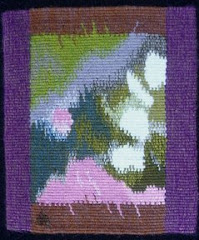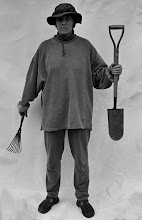at the Textile Museum, Washington DC
March 23 through August 19, 2012
“Museum <Greek mouseion, temple of the muses…”
Jack Lenor Larsen invited 11 artists to each choose a piece (or pieces) from the museum’s collection, to use as their muse while creating a new, contemporary textile. The new pieces are displayed next to their muses, to (as the exhibit guide says) “reflect the connections between past and present.”
The artists are Olga de Amaral, James Bassler, Polly Barton, Archie Brennan, Lia Cook, Helena Hernmarck, Ayako Nikamoto, Jon Eric Riis, Warren Seelig, Kay Sekimachi, and Ethel Stein.
As a tapestry weaver, I was drawn to the exhibit because of the contemporary tapestry, but I knew I would also find other interesting pieces in the show. Unfortunately there was no catalog, and I was not allowed to photograph the exhibit. I’m sorry I have to write this without images, but you can look at a slideshow on the Textile Museum’s website here. (I had to use Google Chrome to see Archie’s slide full sized, it would not work on Firefox). You might want to open the slideshow in a separate window so you can refer to it as you read.
The first piece I saw was Archie Brennan’s tapestry “Sharing a Warp – a Meeting of Pure Chance – Asia/Mexico/the Himalayas - Seeking Unity 2011.” The title refers to the 3 pieces from the museum’s collection that he “chose” at random: pair of white embroidered festival pants from Mexico, a Kira from Bhutan , and a 19th century Shirvan rug from the Caucasus.
Archie calls this piece a “pseudo-collage,” because he created an illusion of 3 pieces one on top of the other, even weaving subtle shadows to indicate how they are layered. I was interested to see that Archie used the technique of doubling warps to change the sett. He used 10 ends per inch to weave the text at the bottom, which reads “…three works chosen at random from the collection of the Textile Museum Washington…” but then doubled the warps to create a coarser texture of 5 ends per inch for the Shirvan rug section. This coarser texture reproduces the pile of the original rug, and also allowed him to use pick and pick to make bold vertical stripes representing the fringe. He says that the fringe was a way to emphasize its “hanging nature.”
Above the rug are the two other references, the finely embroidered Mexican pants on the left, and the diamond patterned Kira on the right. I was particularly drawn to the Kira, where Archie used various woven patterns of dots, stripes, checks and diamonds inside each diamond shape, and the triangles forming the background; the woven patterns are intended to emphasize the cloth nature of the Kira, and they gave me a sense of deja vu, as if I had seen them as a sweater or a tie in a much earlier Archie Brennan tapestry.
The diamond shapes are not centered, so the width of the yellow outlines varies, creating an amusing distortion. Archie said he did that because he felt it was getting too symmetrical. He says he also pulled the warp slightly off vertical in another area, although I can’t see it from the photo. Another detail that caught my eye was the visible shiny red stitches holding together the vertical stripes.
Archie wove this tapestry without a cartoon, just using some sketches, notes and working drawings where needed. He said he loves the journey up the weaving, and the way the tapestry grows on the loom, and admitted that he had been influenced in this method of working by Susan Martin Maffei.
Lia Cook’s jacquard weaving “Coptic Manga” blew my mind. Her muses were 2 small Coptic tapestry fragments, and I recognized the faces in her piece immediately, even with the “altered scale.” The piece looks so different from a distance where the colors blend, and from close up, where you see the woven pattern structure and the separate colors; kind of like an impressionist painting. It made me think about my own black and white tapestries, and my quest to add color to them. The way she has added color to the black and white is reminiscent of hand tinted photographs, or, in this case, comic strips. Very inspiring. If you click on any of her images here you can see a close up of the weave structure.
Jon Eric Riis was inspired by a Chimu jacket from Peru (1250-1350), which might be the most stunning piece in the show, although Riis’s own tapestry jacket is definitely a show-stopper. The “Congressional Constraint Tapestry” is “a straightjacket in politically-charged red and blue, with donkeys, elephants, and hybrids of the two, fringed with boxing gloves.” Tapestry weavers will be impressed that the pairs of boxing gloves (at least 72 pairs, I lost count!) are all individually woven shaped tapestries. The docent said that he had woven them on plane trips. The jacket itself is woven very finely, with glittery metallic thread, silk, horsehair and coral and gold beads.
Helena Hernmarck chose a tiny 9th Century Egyptian rug fragment, and enlarged a detail. With her expressive, loosely woven surface, focusing on color, and showing the pile and the dissolving warp, I had to walk into the next gallery to see it from enough of a distance. Then it became very 3 dimensional.
You can read the Washington Post’s review of the show here. If you live close enough, don’t miss this show!



2 comments:
Love the Textile Museum! Thanks for sharing
Hey you have done a great job keep on working and share more information.
pakistan web development company
web development services pakistan
web design company pakistan
best web solution company
Post a Comment